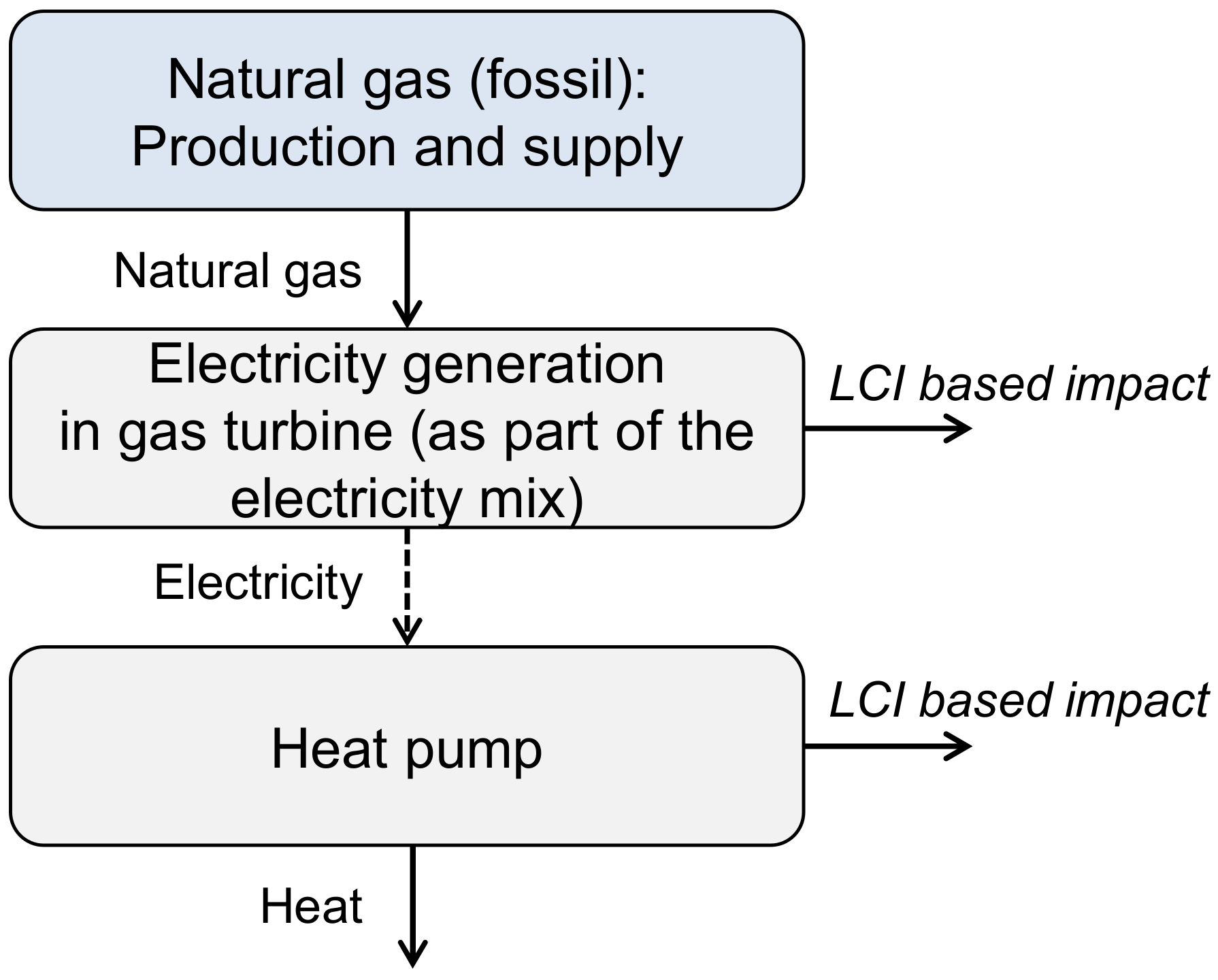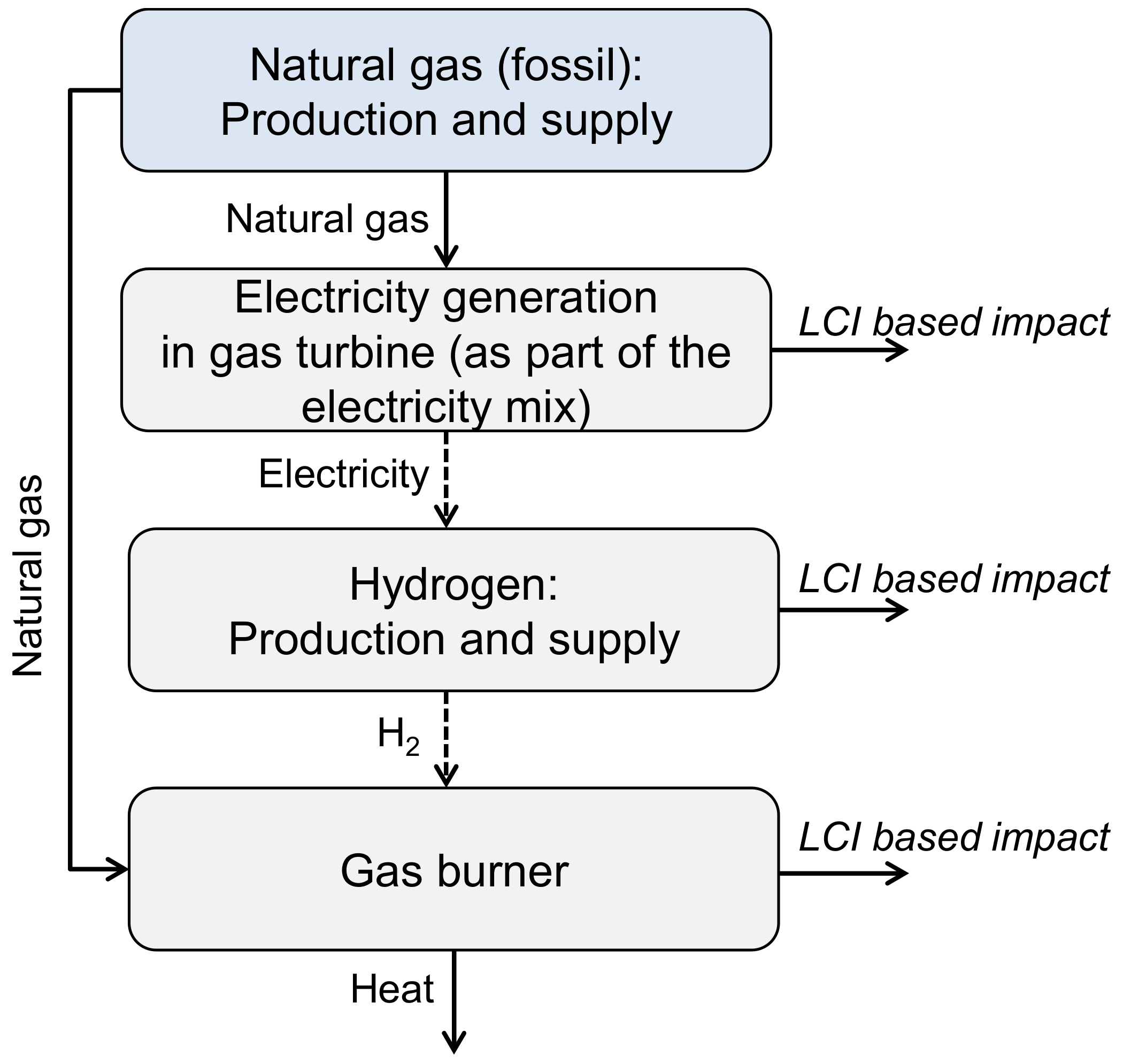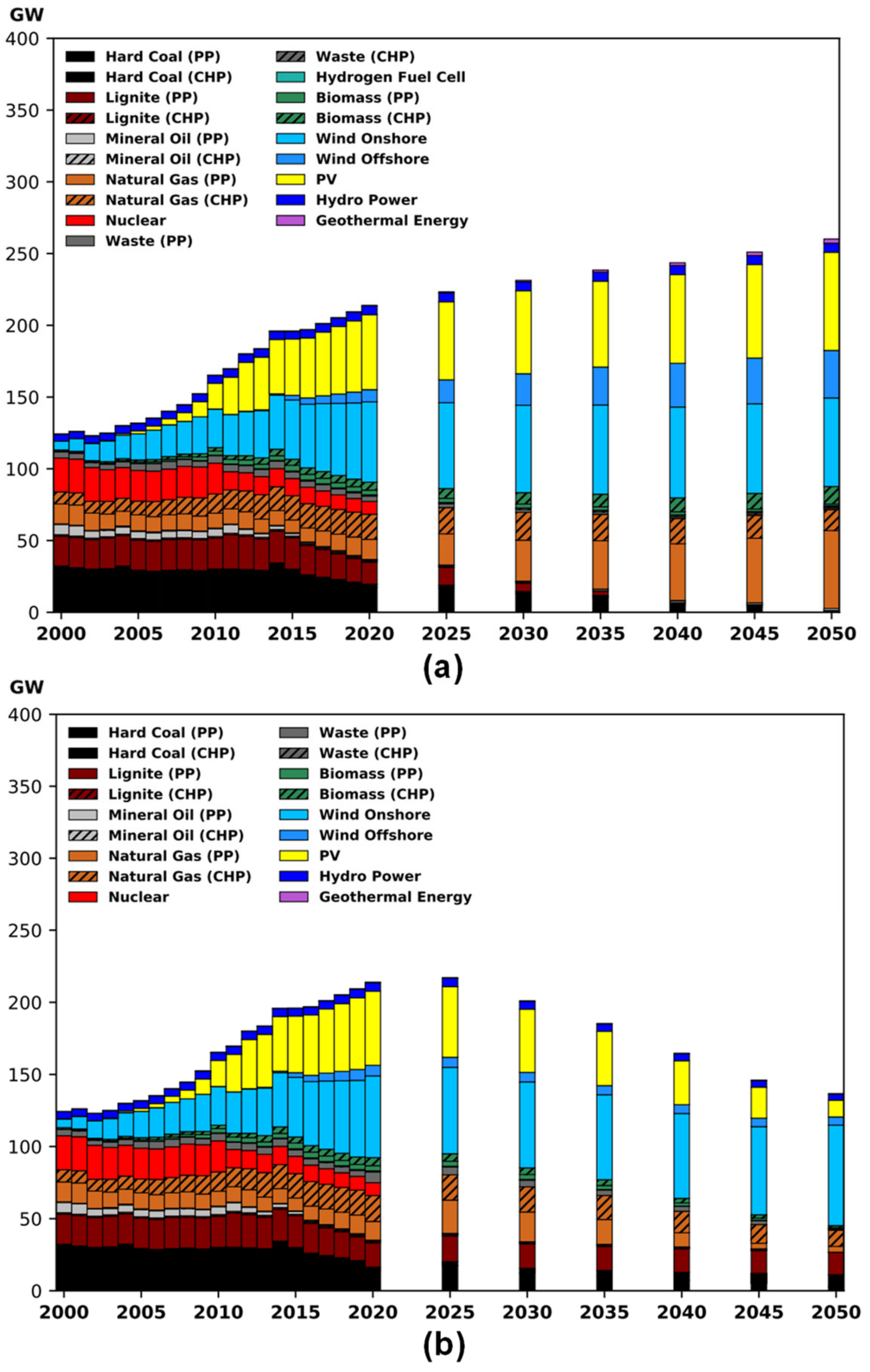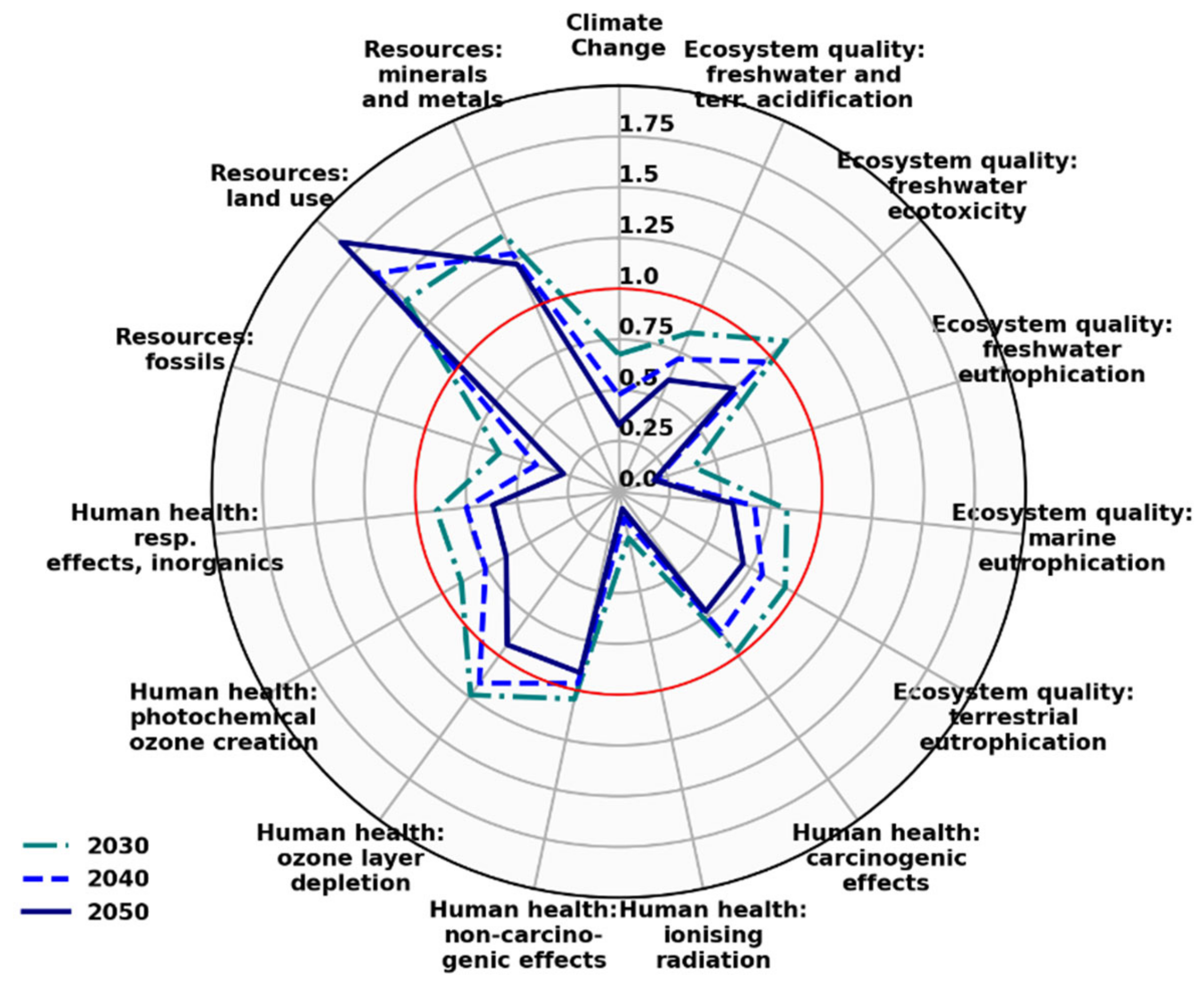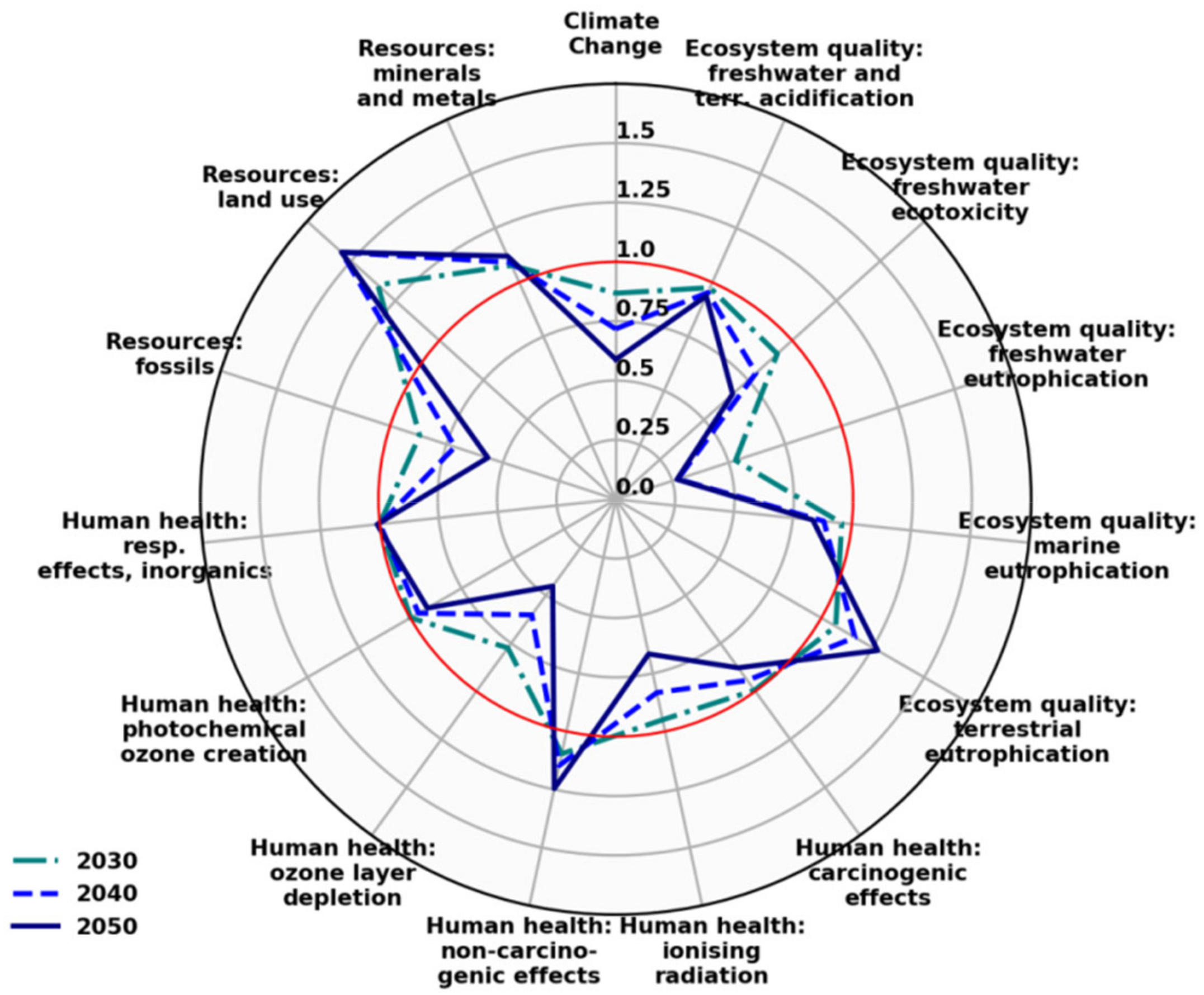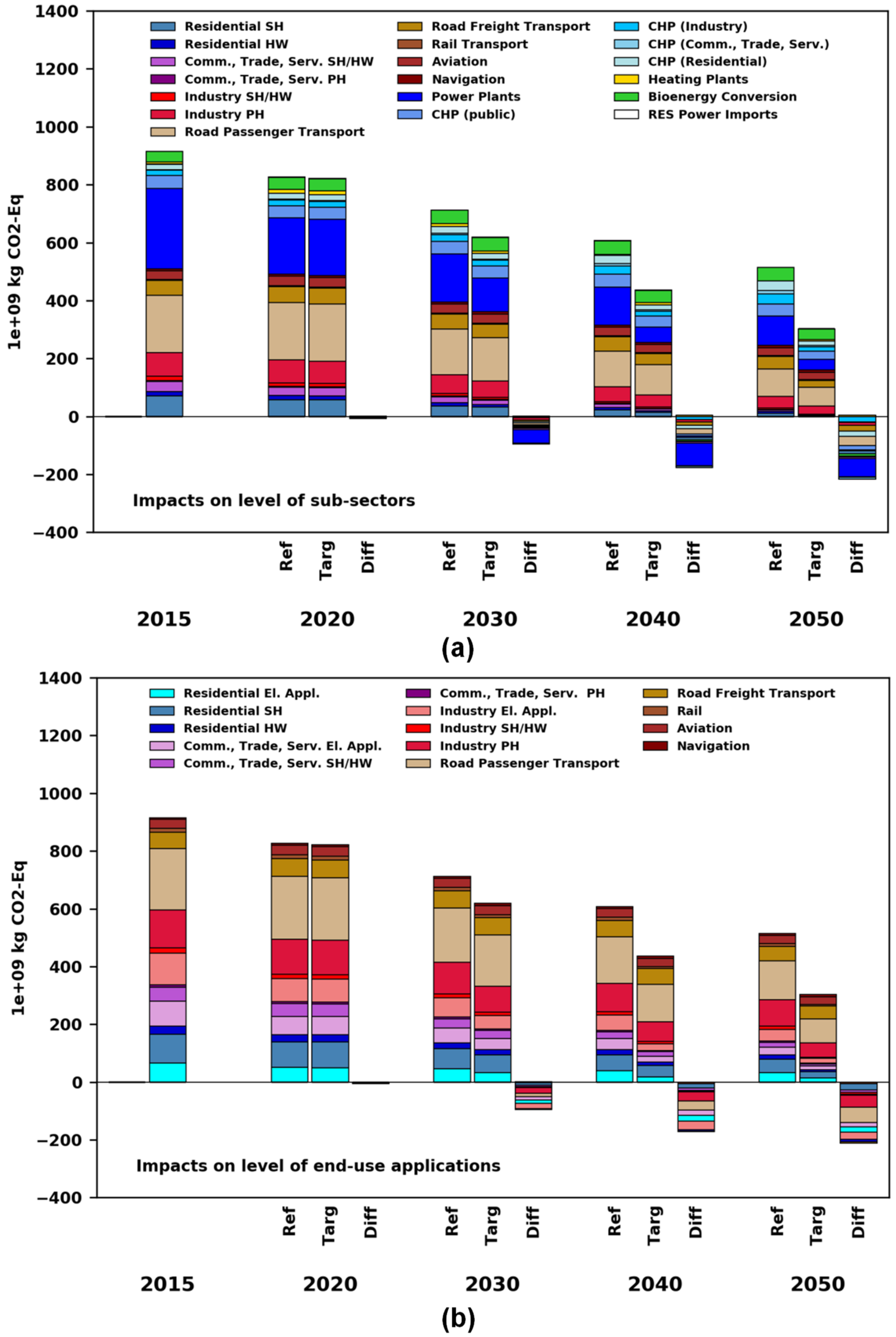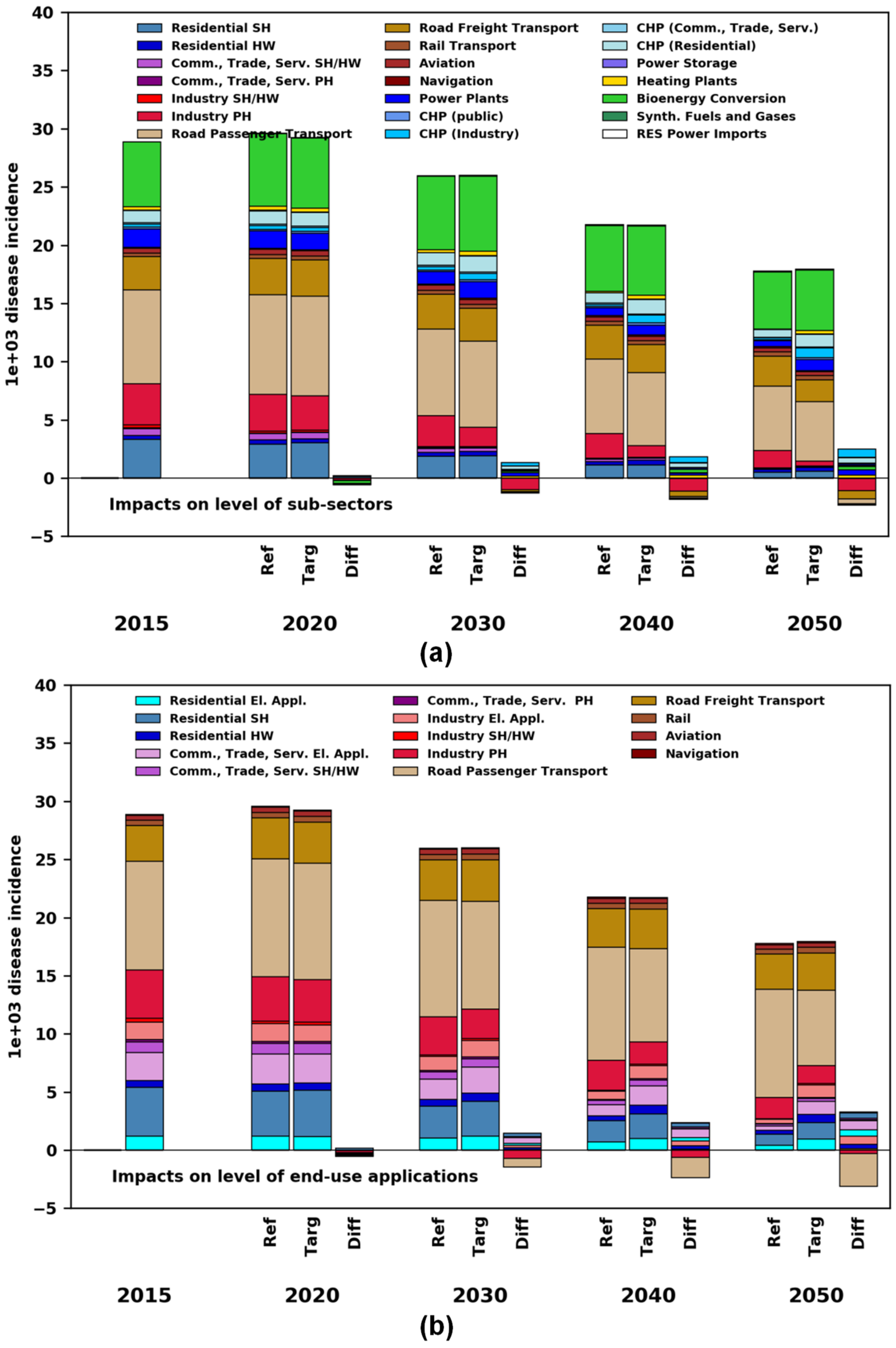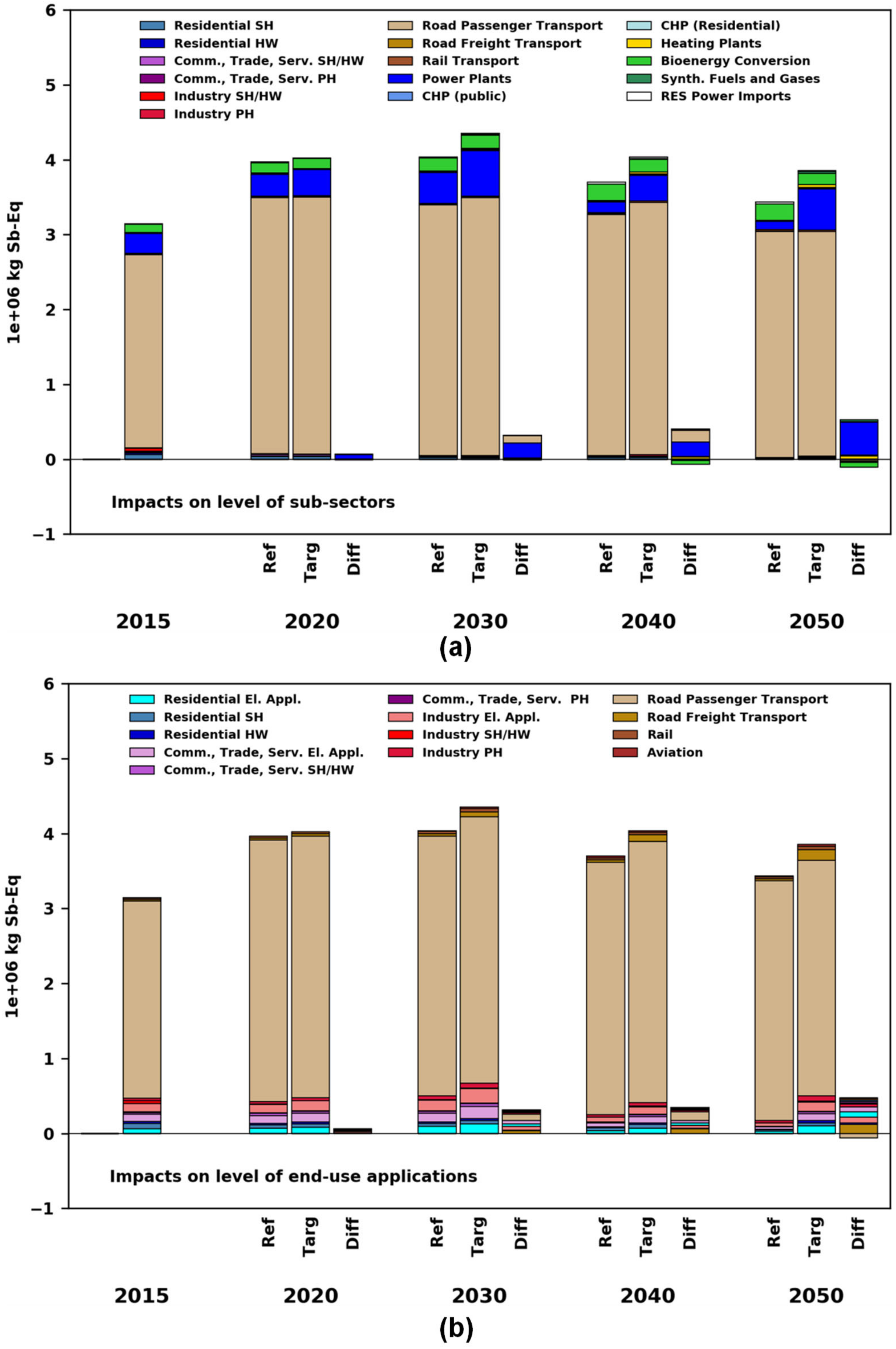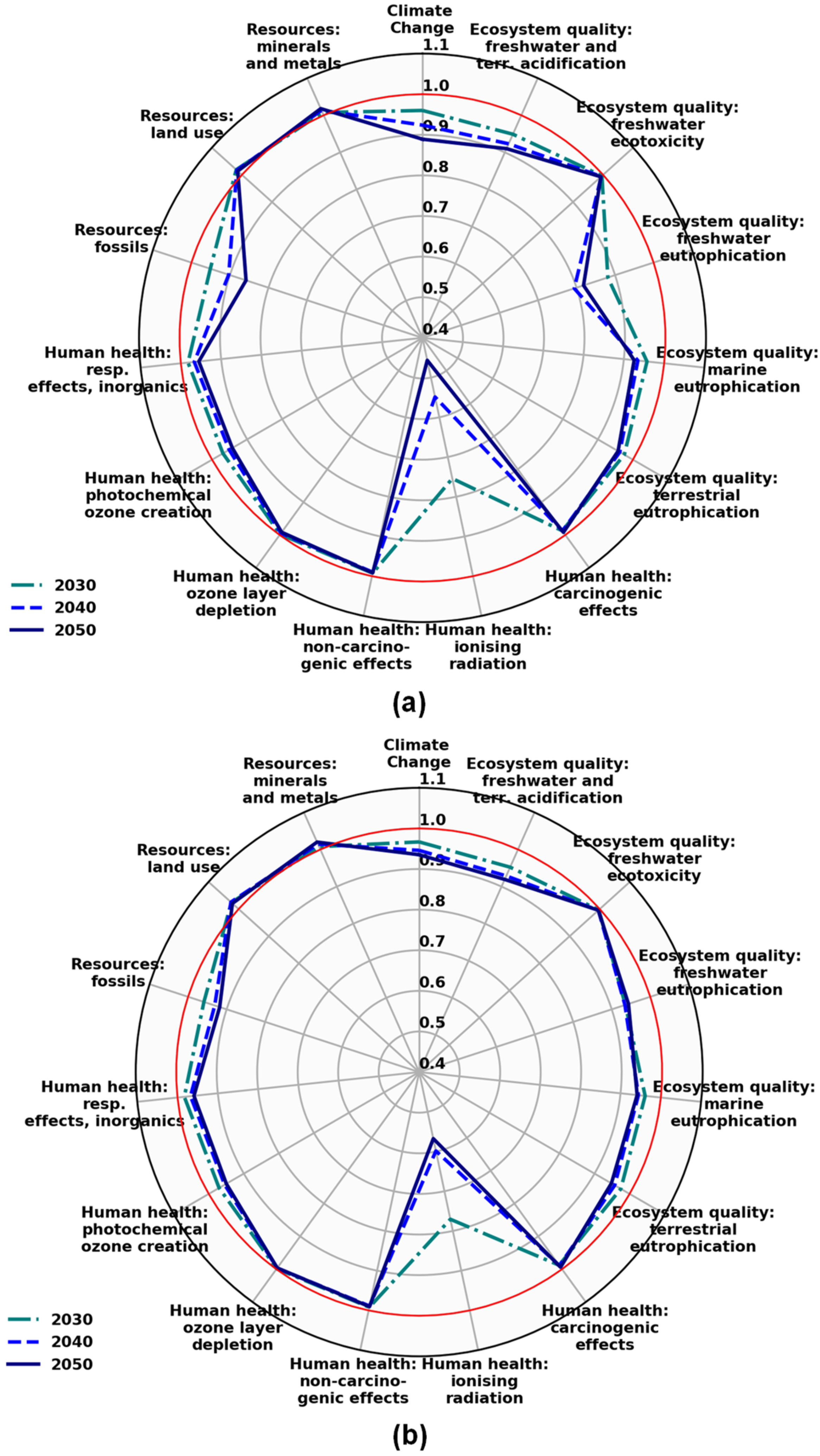1. Introduction
The threat of irreversible effects of global warming led to the agreement at the Paris Climate Conference (COP 21) that the rise in global temperature should remain well below 2 °C and that net greenhouse gas neutrality must be achieved in the second half of the century [
1]. Today, the global energy supply based on fossil fuels is the main source of greenhouse gas emissions. Energy system models (ESMs) are frequently used in order to identify strategies on how to achieve these goals in the most cost-effective and efficient manner. These models depict specific energy conversion sectors such as power supply via the technologies contained therein (e.g., photovoltaic (PV) modules). In the ESMs, the expansion and operation of these technologies are usually driven by techno-economic characteristics combined with CO
2 emission reduction targets for the sectors included. The resulting scenarios at various geographical levels provide important insights into techno-economic and political options for the energy system transformation [
2].
However, ESMs generally do not consider other environmental impacts (e.g., effects on ecosystems). In addition, as energy supply shifts from fossil fuels to renewable sources, environmental impacts tend to shift to processes beyond the traditional system boundaries of ESMs, which usually only include emissions during operation [
3]. Therefore, processes such as the construction of energy conversion plants and other infrastructure elements must be additionally considered. Life cycle assessment (LCA) provides detailed information on a wide range of sustainability indicators by taking full account of the impact of an energy technology on the environment from cradle-to-grave based on the life cycle inventory (LCI). Due to the complementary nature of technology-focused energy system models and LCA with cradle-to-grave environmental impact assessment, their combination can contribute to a more complete picture and knowledge on the sustainability of energy system transformation pathways.
The combination of technologies modelled in ESMs with LCI data is an emerging field of research, currently mainly focusing on the power sector (see
Table 1).
We analysed these studies and classified their approaches in order to identify methodology gaps. Five of the eighteen studies found in the literature assess multi-sectoral energy scenarios that include, next to electricity, also the heating and/or transport sectors [
6,
7,
11,
17,
22]. Concerning the time horizon, a transformation path over longer time horizons (not just a single year) is assessed by less than half of the studies. Few studies disaggregate the environmental impacts into the life cycle phases corresponding to the investment and operation (and partly decommissioning) of the energy technologies in the scenario [
7,
8,
18]. Therefore, environmental impacts of a transformation path can be allocated to the corresponding points in time. This contrasts with the simplifications of other studies that assess a transformation path but do not distinguish between life cycle phases [
10,
12,
16,
17,
19].
Since the application of LCA to energy scenarios has a prospective character, some studies include changes to the background LCI database [
4,
5,
8,
11,
15,
18]. However, the approaches and the degree of these adaptions vary greatly depending on the study. For example, in the technology hybridized environmental-economic model with integrated scenarios (THEMIS), applied in [
5,
8,
15,
18], the electricity mix of a global energy scenario is integrated into the background LCI database and serves as input to all upstream supply processes that consume electricity (e.g., the construction of electricity generation technologies). Volkart et al. [
11] also adapt the background electricity mix for Europe to a scenario for 2030 from literature. In a recent study by Xu et al. [
4], the authors integrate the electricity mix of the applied ESM with a focus on Europe to the LCI database. However, as the technologies are manufactured globally, adjusting the electricity mix of a specific region to future developments may have only a minor impact on the environmental profile of the technologies. Many studies do not consider future evolvements of foreground technologies. An exception is the THEMIS model, where LCIs from secondary literature are used to reflect future changes in material composition and efficiency of the electricity generating technologies. In other studies, foreground technologies and their expected future properties are included in the assessment if corresponding LCIs are available [
4,
7,
11,
19]. Next to the consideration of future material composition for some technologies, the adaption of conversion efficiencies (e.g., in power generation) to the assumptions of the ESM is the most frequently used method.
Despite the growing number of studies, current attempts to combine ESMs and LCA encounter significant methodological challenges. Firstly, most studies cover only a limited number of technologies or have narrow sectoral boundaries (e.g., electricity supply only). This ignores relevant dynamics and interrelationships such as the direct or indirect electrification of transport, industry and households and their environmental impact on specific sectors and the overall energy system. This will become increasingly relevant with increasing electrification of fuels and heat, as will occur at high shares of renewable energy [
2,
23,
24]. In addition, to the best of our knowledge, no environmental ex-post assessment of multi-sectoral energy system transformation pathways with simultaneous adjustment of the global background electricity mix has been conducted. This would lead to a more precise assessment of environmental impacts, especially in the construction phase, which will also gain relevance with increasing shares of renewable energy in the system (see above).
To overcome these limitations, we develop the FRamework for the assessment of environmental Impacts of Transformation Scenarios (FRITS). FRITS provides a basis for coupling multi-sectoral ESMs that assess energy transformation pathways with a high technological detail with an LCI database. FRITS allows for assessing environmental impacts of the entire energy system (electricity, heat, transport and the generation of biogenic and synthetic fuels and gases). Therefore, it is particularly suited for scenarios with a high degree of sector coupling, i.e., direct and indirect electrification of the transport and heat sectors. It further takes into account a number of prospective elements such as the change of the global electricity mix in the background system, the evolvement of plant efficiencies and operation hours. In contrast to the geographical focus of the aforementioned studies—predominantly European countries and the World—we provide the first assessment of transformation pathways of the German energy system.
Germany’s energy system transformation is guided by ambitious political targets until 2050, such as increasing the share of renewable energies in gross final energy consumption to 60% and reducing greenhouse gas emissions by 80–95% (compared to 1990) [
25]. Thus, it can serve as a role model for the transformation of a highly industrialized country. We compare a number of environmental co-benefits and adverse side-effects of an ambitious scenario that meets these political targets (‘Target’) with the current energy system and a baseline (‘Reference’) scenario to deliver insights for policy planning. Specifically, the following research questions are addressed:
How can LCI data be used to evaluate energy system transformation scenarios? Which adjustments need to be made to available LCI data in order to become consistent with the energy scenario, especially in the case of very ambitious scenarios with a central role of power-to-x (admixtures) and biofuels? (
Section 2)
What co-benefits and adverse side effects arise in the transformation of the energy system compared to today? (
Section 3.1.1)
Which indicators decrease or increase at, collectively, the scenario level, the sectoral level (e.g., power generation) and the end-use level when comparing life cycle based environmental impacts for two scenarios for Germany? (
Section 3.1.2 and
Section 3.1.3)
How do life cycle assessments improve the perspective on environmental impacts compared to considering only the direct emissions caused by operation and use? (
Section 3.2)
What influence does the global background electricity mix have on the scenarios assessed? (
Section 3.3)
The scenarios are described in
Section 2.5. Associated uncertainties, as well as further steps to improve the assessment are discussed in
Section 4. Finally, conclusions are provided in
Section 5. With this study, we contribute to the integration of knowledge from the ESM and LCA communities with the aim to increase the robustness of energy scenario assessments. The outputs of FRITS may also serve as inputs for multi-criteria decision making (MCDM).
3. Results
In the following case study, we use a selection of midpoint indicators from the ILCD 2.0 2018 method [
39]. The impact categories used in this study are listed in
Table 4.
3.1. Co-Benefits and Adverse Side Effects at a Sectoral and Overall Scenario Level
In the first two sections (
Section 3.1.1 and
Section 3.1.2), the main sub-sector (see
Table 2) and the corresponding technology most relevant for each indicator is highlighted. A more detailed sectoral analysis is provided in
Section 3.1.3, where we analyse climate change, local emissions and the resulting effects on human health as well as the demand for minerals and metals. The latter two dimensions are selected because they have been recognized in various studies as crucial aspects to monitor when assessing the transformation of the energy system [
40,
41].
3.1.1. Environmental Co-Benefits and Adverse Side Effects of the Energy System Transformation
Figure 6 shows the impacts of the ‘Target’ scenario for 2030, 2040 and 2050 relative to the impacts in 2015. It illustrates that both co-benefits (impact ratio < 1) and adverse side effects (impact ratio > 1) of an ambitious transformation path show a clear increasing or decreasing trend for some impacts, while other impacts first increase and then decrease again. The following analysis focuses on those indicators where the difference between 2015 and the ‘Target’ scenario is at least ±15% in one of the years.
In accordance with previous literature, the energy system transformation causes adverse side effects in the use of minerals and metals as well as in land use [
7,
11]. The increase in the indicator ‘minerals and metals’ can be attributed in particular to road passenger transport, with Otto and diesel engines being substituted by plug-in hybrid electric vehicles (PHEVs) and battery electric vehicles (BEVs) from 2020 onwards. Both car types have a higher specific (per car) value for ‘minerals and metals’, but the increasing sufficiency in road passenger transport assumed in the scenario (lower total passenger km) leads to a slight reduction of this impact category for the years 2040 and 2050 compared to 2030. The widening gap for the indicator ‘land use’ compared to 2015 is mainly due to the use of agricultural land for the production of wood used directly as pellets or in gasification in the bioenergy conversion sector. The strong impact of energy crop cultivation on land use is also highlighted by Volkart et al. [
7].
For the indicators ‘ozone layer depletion’ and ‘freshwater ecotoxicity’, the energy transformation first leads to an increase and then to a decrease in 2050 of the indicators compared to 2015. In 2030 and 2040, ‘ozone layer depletion’ is driven in particular by bioethanol production from winter wheat and grass in the bioenergy conversion sector. The decline in bioethanol production from 2025 to 2050 eventually leads to a better performance of the scenario in 2050 compared to 2015. In 2050, passenger transport, especially BEVs, make the largest contribution to this indicator. The ecosystem quality related ‘freshwater ecotoxicity’ is dominated by passenger transport in all years. In 2030, this dominance is largely driven by Otto and diesel engines, while between 2040 and 2050, BEVs and PHEVs are increasingly responsible for the reduced impact.
As shown in other studies [
6,
8,
18], the phase-out of fossil power plants, specifically lignite-based power generation, leads to a considerable reduction of the indicators ‘climate change’, ‘fossils’, ‘carcinogenic effects’, ‘marine eutrophication’, ‘freshwater eutrophication’ as well as ‘freshwater and terrestrial acidification’. The decline in the indicator ‘respiratory effects, inorganics’ is due to the declining use of Otto and diesel engines in road passenger transport, but also to the decline in the use of coal and the switch to solar thermal production for process heat for industry. Passenger transport also drives most of the reductions in ‘photochemical ozone creation’ and ‘terrestrial eutrophication’. The phase-out of nuclear power plants by 2022 leads to a sharp decline of ‘ionizing radiation’.
3.1.2. Comparison of the Impacts of the ‘Reference’ and ‘Target’ Scenarios
Figure 7 shows the impacts of the ‘Target’ scenario relative to the impacts of the ‘Reference’ scenario for 2030, 2040 and 2050. The differences between the scenarios per indicator mostly follow a clear trend with increasing years. This is also true at the level of the responsible sub-sectors. Therefore, the following analysis focuses on the year 2050. In addition, only indicators where the difference between the ‘Target’ and ‘Reference’ scenarios is at least ±15% in 2050 are analysed in more detail.
Significant higher impacts in the ‘Target’ scenario, i.e., adverse side-effects, can be observed for the indicators ‘land use’, ‘non-carcinogenic effects’ and ‘terrestrial eutrophication’, while ‘minerals and metals’ is only slightly affected. Higher land use impacts are primarily driven by the bioenergy conversion sector, i.e., agricultural land for energy crops such as short rotation forestry for the production of wood pellets or in gasification as well as rapeseed for biodiesel production. The difference of human-health-related ‘non-carcinogenic effects’ is driven by the greater share of heat and power co-generation in industry using wood chips and the higher production of biodiesel and biogas in the bioenergy conversion sector. Biogas production from energy crops also accounts for most of the larger impacts in ecosystem quality related ‘terrestrial eutrophication’.
Similar impacts of the ‘Target’ scenario compared to the ‘Reference’ scenario for all years occur for the indicator ‘respiratory effects, inorganics’. The indicators ‘photochemical ozone creation’, ‘carcinogenic effects’ and ‘freshwater and terrestrial acidification’ are slightly lower. Significantly lower impacts can be observed for the indicators ‘climate change’, ‘fossils’, ‘ozone layer depletion’, ‘ionising radiation’, ‘marine eutrophication’, ‘freshwater eutrophication’ as well as ‘freshwater ecotoxicity’. Declining impacts of ‘climate change’ and ‘fossils’ in the ‘Target’ scenario are mainly caused by the phase out of lignite-based generation by 2038 and the deployment of electric vehicles which reduces fossil fuel demand and emissions from combustion. The power plant sector is also responsible for most of the differences of ‘marine eutrophication’ and ‘freshwater eutrophication’ in 2050. The difference in the human health related indicator ‘ozone layer depletion’ is mainly caused by the lower production of bioethanol from winter wheat and grass in the bioenergy conversion sector. The latter and road passenger transport, especially the significant reduction of Otto engines, are responsible for the majority of the differences in ‘freshwater ecotoxicity’ in 2050. The difference in ‘ionising radiation’ is due to road freight and passenger transport, as less petroleum is produced, the process in which most impacts occur in 2050, e.g., from naturally occurring radioactive material.
3.1.3. Impacts for Selected Indicators at the Level of Technology Groups and End-Use Sectors
In the following section, the assessment is conducted both at sub-sector level and for EUAs (see
Table 2) and, if relevant, the technology of the sub-sector responsible for most of the respective impacts is highlighted.
3.1.4. Climate Change
Between 2015 and 2050, total life cycle CO
2 eq decrease by 44% and 67% in the ‘Reference’ and ‘Target’ scenario, respectively (see
Figure 8). This results in a difference between the two scenarios of 211 Mt CO
2 eq in 2050.
In both scenarios and all years, the main drivers in the sub-sectors (
Figure 8a) are road freight and passenger transport as well as power generation. In 2050, the impacts related to freight transport are dominated by light and heavy duty vehicles with diesel engines, although in the ‘Target’ scenario they are operated to a larger extent with bio-based fuels or hydrogen. In the ‘Target’ scenario, there is also a greater technological shift in passenger transport with an increased use of PHEVs and BEVs. Thus, the higher direct and indirect electrification of both transport modes in the ‘Target’ scenario leads to a reduction of total climate change impacts.
As described above, the phase out of coal based generation and the switch to renewable electricity and natural gas in the ‘Target’ scenario leads to a strong decrease of overall greenhouse gas emissions, in particular during the operation phase of the power plants. In 2050, in addition to the dominant gas-fired power plants, 19% of total emissions in the power sector would be accounted for by rooftop PV. Furthermore, emissions from biomass cultivation and supply in the bioenergy conversion sector are driven by biodiesel production in the ‘Target’ scenario and bioethanol production in the ‘Reference’ scenario.
The column ‘Diff’ shows the difference between both scenarios for each year. If the difference is negative for a given sector, then the impacts from the ‘Target’ scenario are lower in this sector compared with the ‘Reference’ scenario. This means that ambitious climate protection has co-benefits in the respective sector and impact category. On the other hand, if the difference is positive, ambitious climate protection comes along with adverse side effects. All the aforementioned sectors emit absolutely less in the ‘Target’ than in the ‘Reference’ scenario.
In line with the sub-sectors, all the EUAs perform better in the ‘Target’ scenario than in the ‘Reference’ case in all years. In both scenarios, emissions caused by different end-use sectors in 2050 are dominated by passenger and freight cars as well as process heat production for the industrial sector (see
Figure 8b). The avoided CO
2 eq in the ‘Target’ scenario are mainly due to road passenger transport and industrial electric appliances. The large emission differences in power generation between the two scenarios (see
Figure 8a) are thus now particularly reflected in passenger road transportation and industrial electric appliances due to the higher degree of direct electrification of these applications in the ‘Target’ scenario compared to the ‘Reference’ case.
3.1.5. Disease Incidences
The disease incidences of the two scenarios are reduced by 39% and 38% between 2015 and 2050 respectively for the ‘Reference’ and ‘Target’ scenarios (see
Figure 9). Over the whole time horizon, both scenarios reveal quite similar impacts on the scenario level, while the shares of the sub-sectors in the overall impact become increasingly different over time between the scenarios.
In 2050 and in both scenarios, the main drivers for disease incidences of the sub-sectors (
Figure 9a) are road passenger and freight transport as well as the bioenergy conversion sector. Similar to climate change, the impacts related to freight transport are dominated by light and heavy duty vehicles with diesel engines. Disease incidences from road passenger transport in the ‘Reference’ scenario mostly stem from vehicles with Otto engines (in the scenario they have almost three times the annual mileage in 2050 compared to diesel engines). In the ‘Target’ scenario, the impact is dominated by PHEVs with Otto engines but also from BEVs where the impact is shifted towards the construction phase of the vehicle. Most of the impacts in the transport sector are caused by PM
2.5 emissions. In the bioenergy conversion sector, on the other hand, impacts in the ‘Reference’ scenario are mainly driven by SO
2, NH
3 and NO
x emissions from cultivating of winter wheat and grass for the production of bioethanol, whereas in the ‘Target’ scenario NH
3 emissions during the fermentation process for biogas production are the main cause.
The sectors where disease incidences are comparably smaller in the ‘Target’ scenario compared with the ‘Reference’ scenario are mainly freight and road passenger transport as well as process heat in industry (
Figure 9a). However, these positive effects are counterbalanced by increased impacts for combined electricity and heat production for industry and residents where emissions mainly result from the increasing combustion of solid biomass. Likewise, respiratory diseases in the ‘Target’ scenario from the electricity sector are higher than those in the ‘Reference’ case, especially due to the higher installation rate of rooftop PV with high impacts during construction.
In the EUAs perspective, in both scenarios in 2050, passenger and freight cars are clearly the main contributors to respiratory disease impacts due to the large consumption of bio- and synthetic fuels and electricity (see
Figure 9b). The impacts of road passenger transport are smaller in the ‘Target’ scenario compared to the ‘Reference’ scenario, mainly because of the higher direct and indirect electrification in the ‘Target’ scenario compared to the use of biofuels in the ‘Reference’ scenario. On the other hand, impacts from the residential and industrial electrical appliances are higher in the ‘Target’ than in the ‘Reference’ scenario due to higher impacts from power generation in the former (see
Figure 9a). Higher impacts in the EUA residential heat in the ‘Target’ scenario are cause by the greater use of biomass.
3.2. Resource Depletion of Minerals and Metals
Between 2015 and 2050, the resource depletion of minerals and metals increases by 9% in the ‘Reference’ scenario and by 23% in the ‘Target‘ scenario (see
Figure 10).
In a sub-sectoral perspective, in both scenarios and for all years, the main driver is road passenger transport (
Figure 10a). However, the comparatively stronger expansion of PHEVs with Otto engines and BEVs in the ‘Target’ scenario only contributes slightly to the adverse side effects. In the electricity sector, which is responsible for most of the higher impacts of the ‘Target’ scenario, the strong increase in rooftop PV in particular increases the material intensity. While the peak in the ‘Reference’ scenario in 2030 is also attributed to rooftop PV, the impact in the following years in the ‘Reference’ scenario is mainly driven by wind-onshore power plants and is noticeably decreasing. Bioethanol production accounts for a large part of the impacts of the bioenergy conversion sector in the ‘Reference’ scenario. In the ‘Target’ scenario, the effects of bioenergy conversion are driven by bioethanol, biodiesel and biogas production, leading to slight co-benefits in this sector. In the ‘Target’ scenario, the use of flat and tube solar collectors as local heating systems causes most of the impact in this sector.
From an EUAs perspective and in line with the sectoral perspective, passenger cars cause most of the impacts of both scenarios (
Figure 10b). Freight transport plays a larger role, as it consumes parts of the liquid biofuels where impacts are associated with the respective infrastructure (e.g., biomass conversion plants). The greater extent of direct electrification results in a comparably higher impact in most other EUAs in the ‘Target’ scenario compared with the ‘Reference’ scenario. The only exception is road passenger transport, where slight co-benefits arise due to the larger share of indirect electrification in the ‘Target’ scenario compared to the ‘Reference’ scenario via H
2 and the comparatively small contribution of electrolysis to this indicator.
3.3. Influence of Different Life Cycle Phases
To analyse the influence of different life cycle phases in this section, the operation phase is subdivided into direct impacts of the foreground technologies (i.e., direct, on-site operation-dependent emissions) and indirect impacts occurring outside the system boundary of the ESM (e.g., impacts from the production and supply of natural gas). The impacts of the operation that stem from upstream processes are calculated as the difference between the total life cycle impacts of the operation and the direct emissions.
Figure 11 shows the relative contribution of these phases for each impact category considered for 2015 (first bar) and for the ‘Reference’ (second bar) and the ‘Target’ (third bar) scenarios in 2050. In general, in can be observed that the relative shares of those life cycle phases vary strongly between the different indicators. They also vary, albeit to a lesser extent, in the time between scenarios.
Direct emissions play the dominant role (>50% of absolute impacts) for four out of fifteen indicators in 2015 (‘climate change’, ‘marine eutrophication’, ‘terrestrial eutrophication’, ‘photochemical ozone creation’). For most of these indicators, however, there is a shift in the relevance of the life cycle phases towards the construction of energy technologies. In 2050, direct emissions account for an increasingly small proportion of total impacts in most of these impact categories.
For example, the share of direct CO2 eq emissions in the ‘Target’ scenario is reduced from 73% in 2015 to 56% in 2050. The limited shift of the LCA phases for ‘terrestrial eutrophication’ can be explained by the fact that road freight and passenger transport as well as the bioenergy conversion sector, which emit most of NH3, NO3 and NOx, do so at a relatively similar share in 2015 and in 2050 in both scenarios. Especially in the ‘Target’ scenario, emissions such as NOx, CH4 and other volatile organic compounds that contribute to ‘photochemical ozone creation’ are slightly shifted to the construction phase of the energy technologies, especially in road passenger transport.
For the three indicators ‘freshwater and terrestrial acidification’, ‘non-carcinogenic effects’ and ‘respiratory effects, inorganics’, the share of direct emissions in total impacts is still above 10% in 2015. On the other hand, for all other indicators, direct emissions make only a small to no contribution (<5%) to total impacts. This is the case in all ‘resources’ type impact categories and for some impact categories that address ‘human health’ as well as ‘ecosystem quality’. Here the effects either occur mostly in the construction phase of the energy technologies or in processes upstream of the operation phase.
This analysis shows that solely considering direct impacts during the operation phase significantly underestimates the total environmental impacts of the energy system. However, the amount of underestimation depends strongly on the respective indicator and on the configuration of the energy system itself, but is expected to become increasingly relevant as scenarios become more ambitious in terms of climate protection.
3.4. Influence of the Global Background Electricity Mix on the Scenarios
Figure 12 shows the influence of the global background electricity mix of the 2 °C scenario relative to the 5 °C scenario from Teske et al. [
2] on the indicator values of the ‘Target’ (
Figure 12a) and the ‘Reference’ (
Figure 12b) scenarios. The influence of the global background electricity mix on the individual indicators varies in its extent between the ‘Target’ and the ‘Reference’ scenario, as the electricity intensity of all upstream processes (in construction and operation) differs for the processes and technologies relevant in the scenarios. As illustrated in
Figure 11, the construction phase is more dominant in the ‘Target’ scenario than in the ‘Reference’ scenario. Thus, there is a more pronounced influence on the former (
Figure 12a). For most indicators, the influence increases with the development of the transformation of the global electricity mix towards deeper defossilisation.
In the ‘Target’ scenario, the effect of the background scenario is largest (>10%) for the indicators ‘climate change’, ‘fossils’, ‘freshwater eutrophication’ and ‘ionizing radiation’, whereas in the ‘Reference’ scenario this effect occurs only for the latter. For the indicator ‘freshwater eutrophication’, the positive effect in the 2 °C scenario in 2050 weakens somewhat again (especially visible in the ‘Target’ scenario), since the Si-based open ground and roof-top PV systems increasingly deployed in the 2 °C scenario show relatively high values for this indicator compared to other conventional power plants more dominant in 2040 (e.g., gas-fired power plants). The strongest effect can be seen for the indicator ‘ionising radiation’, as the 2 °C background scenario, in contrast to the 5 °C background scenario, phases out the use of nuclear and coal-fired power plants, the strongest sources of ionising radiation in power generation. A detailed sectoral and technological analysis of the effect of the background power mix on environmental impacts is subject to future assessments.
In general, the influence of the background electricity mix on the foreground scenario is particularly relevant for scenarios that are more ambitious in terms of CO2 emission reduction and thus have a high proportion of impacts embedded in upstream processes, especially in the construction of the necessary infrastructure. This will be even more relevant for scenarios with CO2 targets on direct emissions beyond a 95% reduction, which are increasingly relevant in the community.
4. Discussion
4.1. Uncertainties Regarding Life Cycle Inventory Data
In line with most previous literature (see
Section 1), the ecoinvent database provides most of the LCIs used for this study. The coverage of technologies in ecoinvent 3.3 is good for the electricity sector, although rather limited for non-electricity technologies from the conversion sector (e.g., biofuels, synthetic fuels), transport sector (e.g., BEVs and FCEVs as well as PHEVs) and heat sectors (e.g., industrial heat pumps and solar collectors) and not always fitted to German technologies. In FRITS, some of these shortcomings have been corrected in terms of the level of detail, novelty and completeness of technologies, for example by incorporating LCIs from e.g., BioenergieDat, the SYSEET project, more recent PV data and so far missing technologies such as state of the art electrolysers and heat pumps. In the processes of the bioenergy conversion sector, however, there is still an under-representation of the LCIs on secondary biomass (e.g., biowaste).
Some technologies from the supplemented database had to be assigned to technologies from the model, although their properties do not fully match with respect to the process/technology itself or its scale (e.g., performance class). Future steps will therefore evolve from the best possible completion of technologies in the ESM towards a better harmonization and representation. In some cases, only a single LCI data set is available per technology class, but in reality the system is described by many different subtechnologies for which differentiated LCIs are favorable for future studies.
The LCIs are based on current technologies and future technological developments are considered by adjusting the energy efficiencies (see
Section 2.3.4). However, it can be expected that emission factors will change for existing technologies, e.g., due to increased partial load operation or updated emission control systems. Also, for future technologies with different fuel inputs (e.g., biogas in Otto engines) the database has to be extended by respective inventories. Furthermore, material inputs may evolve over time. In future studies, this must be countered either by a further integration of LCIs from the secondary literature that describe a prospective development of the technology under consideration or by the inclusion of generally valid learning curve models (similar to economic learning curve models) to enable the inclusion of material efficiency improvements in existing LCIs and background production processes.
Future global changes in production schemes in the background database were adapted for the electricity mix, which appears to be more relevant as the degree of ambition of the foreground scenario increases and the background becomes increasingly defossilised. Yet, it is to be expected that heat and transport mixes as well as industrial and material extraction processes will also change fundamentally if a defossilisation of the entire energy system is to be achieved.
4.2. Methodological Limitations
Due to the regional structure of the LCI database, it is not possible to distinguish which operation-dependent (indirect) and infrastructure processes and their environmental impacts can be assigned to the geographical system boundary of the ESM (in this case Germany). Further regionalisation of the background database would help to assign processes and impacts to specific regions and would facilitate the inclusion of region-specific scenarios for sectors such as heat and transport. However, this requires not only an adaption in the structure of the database such as the introduction of regionally differentiated markets (e.g., for heat and transport) but also the integration of new LCIs of future relevant processes and scenarios regarding their deployment.
Higher regionalisation of the background database would also have the advantage that double counting and thus the overestimation of environmental impacts at the level of the overall scenario could be better avoided, since the regions considered in the model and the processes depicted in it could be better identified and deleted from the LCI database before the impacts are calculated. The overestimation of impacts due to double counting increases with the inclusion of more sectors (e.g., next to electricity also heat, transport, etc.) and regions (e.g., worldwide) in the ESM. In future studies, input-output tables could be used in order to obtain information on country-specific international trade flows, which in turn could be integrated into LCI databases to increase the regional resolution (e.g., of material, heat and transport supply).
However, such adaptions of the background database are difficult to operationalise with the current software tools. Thus matrix-based approaches, such as those presented in Mendoza Beltran et al. [
42], Vandepaer et al. [
43] or Fernández Astudillo et al. [
6], are becoming increasingly relevant, which also meet the transparency criteria proclaimed by parts of the research community [
44,
45].
The models used to derive the indicators of the ILCD method are subject to regular quality assessment [
39]. While the quality of the indicators ‘climate change’ and ‘respiratory effects, inorganics’ analysed in
Section 4.1 is considered to be high, the implications of the indicator ‘minerals and metals’ (next to others) must be treated with great caution. This is because the characterisation factors for each metal are derived from the ratio of annual production to reserves, which fluctuate over time as they are defined by economic considerations not directly related to the depletion problem [
46].
Apart from the uncertainty of specific indicators, the linearised approach of the LCIA methods cannot take into account scale variations of impacts, e.g., due to saturation or threshold effects or interactions between different environmental impacts. These issues are partly addressed by the current work of the LCI initiative to improve the LCIA by incorporating further environmental aspects and using harmonised environmental models [
47]. Furthermore, impacts are subject to spatial variability, which argues for the use of a spatially differentiated database and regionalized impact assessment methods.
A thorough assessment of all the uncertainties of the assessment stemming from various sources, however, is far beyond the scope of this study. Nevertheless, these aspects point the way for the future development of FRITS.
5. Conclusions and Outlook
The coupling of LCA-based indicators with ESMs enriches the impact assessment of the long-term transformation of energy systems initiated by climate policy. FRITS can provide policy makers and stakeholders with additional information on environmental co-benefits and adverse side effects usually not covered by ESMs. Since it is possible to consider the entire energy system and not only individual energy sectors, the results give a comprehensive picture of the environmental impacts of transformation pathways and can also provide input for subsequent MCDM approaches. FRITS is, in particular, well suited for the assessment of very ambitious climate protection strategies that are characterised by a high share of sector coupling and a prominent role of synthetic gases and fuels for (seasonal) energy storage and the defossilisation of transport and (process) heat. FRITS is transferable to other ESMs that have a different technological and regional scope than the MESAP model used in this paper. It can thus be the basis for future assessments of various mitigation strategies.
The results of the case study show that the ambitious climate protection pathway represented by the ‘Target’ scenario results in a decrease of environmental impacts relative to 2015 and in comparison to the ‘Reference’ scenario for most indicators. However, the ‘Target’ scenario is associated with a significant increase in material and land use and aggravates some human health and ecosystem related impacts. The most controversial picture emerges for the bioenergy conversion sector as it contributes significantly to the adverse side effects but also to the co-benefits of the ‘Target’ scenario compared to 2015 and to the ‘Reference’ scenario. The electricity sector accounts for a large consumption of mineral resources but is also one of the main drivers for most of the co-benefits. In absolute terms, road transport (passenger and freight transport) might become the largest source of environmental impacts in the future.
Most of the environmental impacts lie outside the typical system boundaries of ESMs, i.e., they cannot be assessed by the consideration of direct emissions from the energy and transport system alone. Thus, the life cycle perspective is highly important in order to assess all relevant environmental impacts and to disclose the risk of burden shifting to other sectors or regions.
The case study presented here mainly discusses results at indicator and sector level. Future assessments could also be conducted at a deeper technological level for individual life cycle phases and specific indicators and elementary flows. This allows for the detection of environmental hot spots on technology level, to identify needs for action with respect to research and development for individual energy and transport technologies and for regulation measures. However, this type of assessment is still in its beginnings and is subject to high uncertainties. The necessary efforts go beyond the mere integration of new, prospective LCIs. They require the integration of comprehensive scenarios into background databases considering not only future electricity, heat and transport processes, but also future developments in industrial and raw material extraction processes. In general, an open database and platform for coupling ESMs to LCA and vice versa, the integration of results from ESMs into LCAs would greatly facilitate the exploitation of the benefits of combining both methods.
In order to derive increasingly robust, scientifically sound decision support for a sustainable transformation of the energy system, future versions of FRITS will integrate further adaptions of the background database and improvements of the quality of LCIs that represent the foreground technologies.

